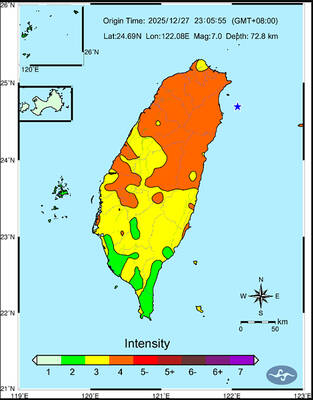It's Monday morning and the wall computer has a few suggestions to start the day: Your blood pressure is high, so how about tofu for dinner? Try another route to work to avoid traffic. And there's no more orange juice, so more's been ordered.
That may sound like an episode of The Jetsons, but developers are making it reality with the construction of a US$25 billion digital city in South Korea. The first 2,000 of a total 65,000 residents are expected to move into their wired homes in 2009.
New Songdo City, which its developers say may be the world's largest ever private development project, is the crown jewel of an ambitious plan by the Seoul government to turn a muddy plot of 607 hectares of reclaimed land on the Yellow Sea into a gateway to northeast Asia.
Built from scratch, it will boast the most advanced digital infrastructure imaginable, from blanket wireless Internet coverage and automated recycling to universal smart cards that can be used to pay bills, access medical records and open doors.
Songdo will merge medical, business, residential and government data systems into a so-called ubiquitous city, or "U-city," on a scale never seen before. There are smaller ubiquitous projects -- the local term for a digital community -- but nothing compares to Songdo.
Homes and offices all have built-in computers that will collect data from swipe cards and sensors for the "U-Life" management center.
"In America and Japan, some building companies use group control or group management, but in our country it's for a whole city," said Jang Choong-moo, director of strategy and new business at Songdo U-Life.
It is the ultimate testing ground for services to track products and people with identification chips -- a technology facing resistance in other countries because of privacy concerns.
Kim Kyoung-woo, a spokesman at the Ministry of Information and Communication, said South Koreans generally trust corporations with personal data and that "it's not a big issue" for the public.
It is unclear exactly how the information will be protected, but Huh Jeong-wha, IT director at Songdo U-Life, says residents will have to give permission before their data can be used.
Liz McIntyre, who co-authored a book on consumer privacy and corporations called Spychips, said South Koreans should be wary.
"Songdo City's anonymous tracking infrastructure could quickly be turned to new purposes, and its people could become virtual prisoners of their own technological creations," McIntyre wrote in an e-mail.
"US companies are having to look outside for places to implement their ubiquitous systems, and have turned to the more trusting people of South Korea for experimentation," she said.

A magnitude 7.0 earthquake struck off Yilan at 11:05pm yesterday, the Central Weather Administration (CWA) said. The epicenter was located at sea, about 32.3km east of Yilan County Hall, at a depth of 72.8km, CWA data showed There were no immediate reports of damage. The intensity of the quake, which gauges the actual effect of a seismic event, measured 4 in Yilan County area on Taiwan’s seven-tier intensity scale, the data showed. It measured 4 in other parts of eastern, northern and central Taiwan as well as Tainan, and 3 in Kaohsiung and Pingtung County, and 2 in Lienchiang and Penghu counties and 1

FOREIGN INTERFERENCE: Beijing would likely intensify public opinion warfare in next year’s local elections to prevent Lai from getting re-elected, the ‘Yomiuri Shimbun’ said Internal documents from a Chinese artificial intelligence (AI) company indicated that China has been using the technology to intervene in foreign elections, including propaganda targeting Taiwan’s local elections next year and presidential elections in 2028, a Japanese newspaper reported yesterday. The Institute of National Security of Vanderbilt University obtained nearly 400 pages of documents from GoLaxy, a company with ties to the Chinese government, and found evidence that it had apparently deployed sophisticated, AI-driven propaganda campaigns in Hong Kong and Taiwan to shape public opinion, the Yomiuri Shimbun reported. GoLaxy provides insights, situation analysis and public opinion-shaping technology by conducting network surveillance

‘POLITICAL GAME’: DPP lawmakers said the motion would not meet the legislative threshold needed, and accused the KMT and the TPP of trivializing the Constitution The Legislative Yuan yesterday approved a motion to initiate impeachment proceedings against President William Lai (賴清德), saying he had undermined Taiwan’s constitutional order and democracy. The motion was approved 61-50 by lawmakers from the main opposition Chinese Nationalist Party (KMT) and the smaller Taiwan People’s Party (TPP), who together hold a legislative majority. Under the motion, a roll call vote for impeachment would be held on May 19 next year, after various hearings are held and Lai is given the chance to defend himself. The move came after Lai on Monday last week did not promulgate an amendment passed by the legislature that

AFTERMATH: The Taipei City Government said it received 39 minor incident reports including gas leaks, water leaks and outages, and a damaged traffic signal A magnitude 7.0 earthquake struck off Taiwan’s northeastern coast late on Saturday, producing only two major aftershocks as of yesterday noon, the Central Weather Administration (CWA) said. The limited aftershocks contrast with last year’s major earthquake in Hualien County, as Saturday’s earthquake occurred at a greater depth in a subduction zone. Saturday’s earthquake struck at 11:05pm, with its hypocenter about 32.3km east of Yilan County Hall, at a depth of 72.8km. Shaking was felt in 17 administrative regions north of Tainan and in eastern Taiwan, reaching intensity level 4 on Taiwan’s seven-tier seismic scale, the CWA said. In Hualien, the